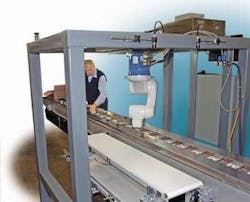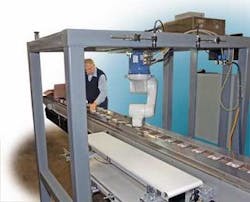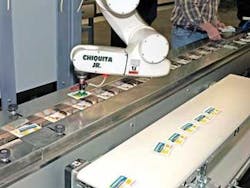Productive Line
Winn Hardin, Contributing Editor
With the decline of traditional, large-scale manufacturing, small businesses hold the promise of industrial growth in the US. However, these businesses have been slow to adopt advanced manufacturing and automation technologies such as machine vision and robotics. The acquisition price of robotics is a major reason why small businesses do not use more automation in their facilities.
“The situation is changing,” notes Greg Raciti, engineering manager at Faber Industrial Technologies, a supplier of industrial automation products. “The cost of vision and robots has come down over the years, as performance has gone up. This makes it more feasible for regular companies to get into vision.”
Another challenge for small manufacturers is that their facility layouts and processes change more frequently than large-scale operations, requiring a certain flexibility on the part of supporting automation. At the request of Market Resource Packaging, a contract packager for newspaper and magazine sample product inserts, Raciti’s company co-developed a mobile vision-guided robotic workcell that can do the work of several manual laborers.
The workcell can pick randomly placed sample packets from an infeed conveyor with a six-axis articulated robotic arm suspended upside-down from a portable metal frame, and place the packets on a glue bead on a flighted, outfeed conveyor. The system uses a pair of DALSA cameras connected to a VA40E multicamera vision appliance running Sherlock 7 image-processing software to locate the packets and cardboard backers on the conveyors and send the offset information to the robot controller. The controller combines the offset data with conveyor speed information to track each packet, picking it when it comes within range of the robot arm and placing the packets on the outfeed conveyor.
Speed, quality, flexibility
The New Jersey facility packages up to 50 samples per minute, attaching each sample to a supportive cardboard backer and shrink-wrapping the sample for direct mail, newspaper inserts, and other types of promotional consumer-based distribution channels. The facility is essentially a warehouse area with product receiving and shipping areas, and several pairs of flat conveyors for sample packets and flighted, or lug, conveyors for holding the cardboard backers. Typically, three workers stand in between the two conveyors, picking samples from one side and gluing them to boards on the other conveyor.
“We were doing this job by hand, but the quality was poor,” explains Scott Conklin, plant manager at Market Resource Packaging, who also designed and integrated the system into the facility with the assistance of Faber Industrial Technologies. “Placement of the product was particularly important to the customer, so we were interested in using a vision system with a robot to improve our quality issues.
“It wasn’t so much about speed,” he notes. “We thought by going with a robot solution, we could maintain our speed while improving quality and cutting labor. We were able to eliminate 24 labor hours per shift and we saw an immediate reduction in our reject rate of 18%.”
The vision-guided robotic workcell needed to be able to be moved from one conveyor pair to the next; have adjustable camera mounts to accommodate conveyors of differing heights, positions, and locations; and perform a simple calibration routine to make sure the machine-vision system and robot work together.
Flighted conveyors use mechanical slides or stops to hold the cardboard backers in place and in a certain orientation. This simplifies the next two steps, which are applying the glue bead to the backer board before the sample packet is attached. Glue bead application is still applied via a gluer on the flighted conveyor.
Before each packaging run, sample packets are filled into a sorting conveyor that spreads the packets across the flat conveyor system. Boards with glue beads are fed into the outgoing conveyor and the vision-guided robot workcell is wheeled over both conveyors (see Fig. 1).
A Toshiba Teli CS8560D 60-Hz, 640 × 480-pixel CCD camera is mounted on adjustable mechanical supports above each conveyor. Each camera is fitted with a Fujinon 12-mm C-mount lens to provide adequate depth of field. Faber is a distributor of DALSA equipment and DENSO Robotics, but Raciti said the Sherlock image-processing software and VA40E processing unit for multiple cameras were both big reasons why they chose the DALSA line.
Easy calibration, fast search
“A big part of making this project work is the ability to calibrate the vision system to the robot coordinate system after the frame has been moved to a new set of conveyors,” explained Raciti. “With the Sherlock software, you simply choose four points in the camera field of view and the algorithm does the rest.”
Both cameras work in constant acquisition mode, feeding images at 60 frames/s to the VA40E processing unit, which runs Sherlock on a Windows XP Professional operating system. After calibrating the cameras to the robot coordinate system, the VA40E uses Sherlock’s “Search – Edge” contour-based, 360° pattern-matching algorithm to locate each packet on the flat conveyor, even when a single image may show three or four different packets (see Fig. 2).
The VA40E finds the packet in each image and calculates the x, y, and rotational positions of the packet on the conveyor. This positional information is relayed to the DENSO RC7 robot controller over an Ethernet connection.
Each conveyor is also fitted with a SICK DRS61 programmable incremental encoder for tracking the speed of the packets as they approach the DENSO VS-6556G VS six-axis robot. Encoder information is sent via twisted-pair cable to a DENSO Dual Conveyor tracking module, which adds this information to the x, y, and rotation coordinates of each packet, allowing the RC7 controller to calculate an offset, and therefore robot path, to each approaching packet (see Fig. 3).
“We’ve mounted a few StockerYale high-frequency fluorescent linear lights along with the cameras on the leading edge of the frame,” says Raciti. “The cameras see the packets first, and the VA40E determines the packet positions. The robot controller cues up each packet’s position in a buffer.
“The camera generally takes 10 to 20 images of each packet before the packet gets into range of the robot. With each image the position is updated and sent to the robot controller. If two packets are too close together for the robot to pick, or if the robot will not be able to reach a packet before it passes out of range, the controller ignores that packet, and it’s recycled back to the beginning of the flat conveyor (see Fig. 4).”
A polyurethane vacuum suction cup is mounted on the end of the DENSO robot to pick up each packet and carry it to the glue bead on the cardboard backer. “We run at 40 to 50 parts per minute, but we’d like to get the cycle time down. Today, the conveyors are father apart than they need to be, but we can improve the cycle time by going from one suction cup to three or four cups, picking up multiple packets per cycle,” says Raciti. “That would cut cycle time.”
In the meantime, Market Resource Packaging is happy with the result. “Thanks to the vision appliance, you don’t need a PhD to calibrate the system, or find the right laptop with the right software to make changes to the program. You connect to the appliance, make any changes you want, and you’re ready to go,” Raciti explains.
Conklin agrees, saying he’s happy with the performance of the portable vision-guided robotic workcell. “The integration went very well. When we looked initially at doing this system, we received quotes from several custom machine builders of up to $200,000. Since my background is in custom machine building, I chose to do the integration myself with my staff. This solution allowed us to build in all the flexibility we need as a contract packager at a much reduced cost. We did this for under $60,000.”
Company Info
DALSA, Waterloo, ON, Canada
www.dalsa.com
DENSO Robotics
Long Beach, CA, USA
www.densorobotics.com
Faber Industrial Technologies Clifton, NJ, USA
www.faberinc.com
Fujinon, Wayne, NJ, USA
www.fujinon.com
Market Resource Packaging Cranbury, NJ, USA
www.mrppackaging.com
SICK, Minneapolis, MN, USA
www.sickusa.com
StockerYale, Salem, NH, USA
www.stockeryale.com
Toshiba Teli America, Irvine, CA, USA www.toshiba-teli.com




